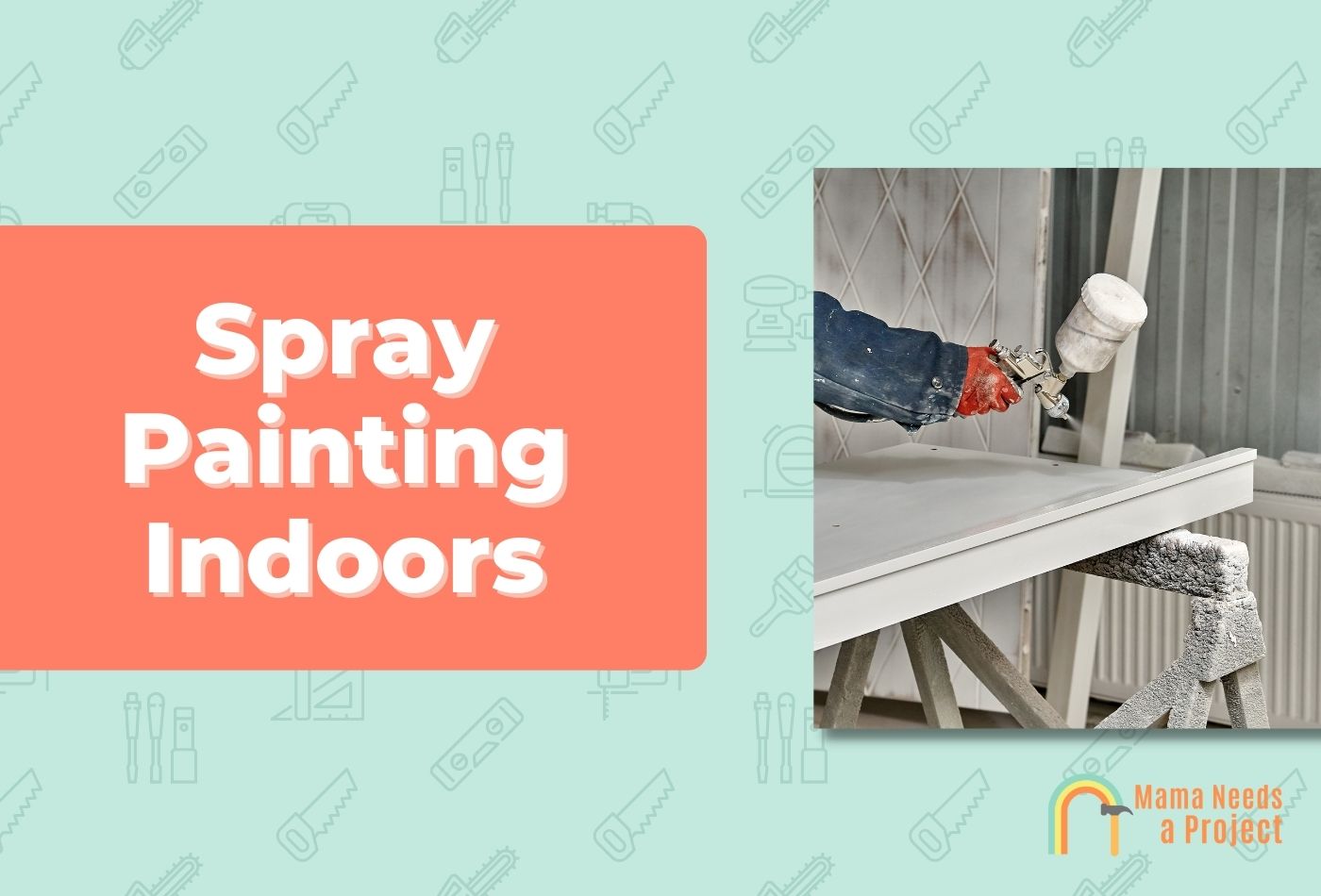Spray Painting Indoors: Is it Possible? (Complete Guide)
Spray paint is one of the easiest ways to give your project new life. It’s cheap, easy to use, and you can find it just about anywhere.
But is spray painting indoors safe and should you do it?
In this post, I’ll explore everything related to spray painting indoors including some tips to help you stay safe and keep your area clean. Let’s dig in!
- Spray painting indoors can be done safely with cans or a paint sprayer, but you’ll need adequate space, ventilation, air circulation, time, and safety gear.
- Unless you can check all these boxes confidently, it’s best to spray paint outdoors.
- You’ll also need a drop cloth paint screen to protect nearby surfaces from overspraying.
Can You Spray Paint Indoors?
Yes, you can spray paint indoors, but it isn’t always the best option, and there are a few things you’ll want to do before you start spray painting indoors.
Whether or not you can spray paint effectively indoors is determined by a range of factors, such as the size of the workpiece, the amount of space you have available, the kind of sprayer you’re using, and the time you have to complete the project.
While it’s true there are many times when you can paint indoors without making a mess, projects that involve much larger workpieces should be painted outside, since you won’t be confined by walls and you won’t have to worry about paint getting on anything important.
Plus setting up a paint screen outdoors is much easier.
In short, if you have the ability to spray paint comfortably indoors, by all means do so. But if you’ll be “pushing it” trying to accomplish this task, it’s best to paint in a more suitable location so you don’t have to clean up a big mess later.
What to Consider Before Using Spray Paint Indoors
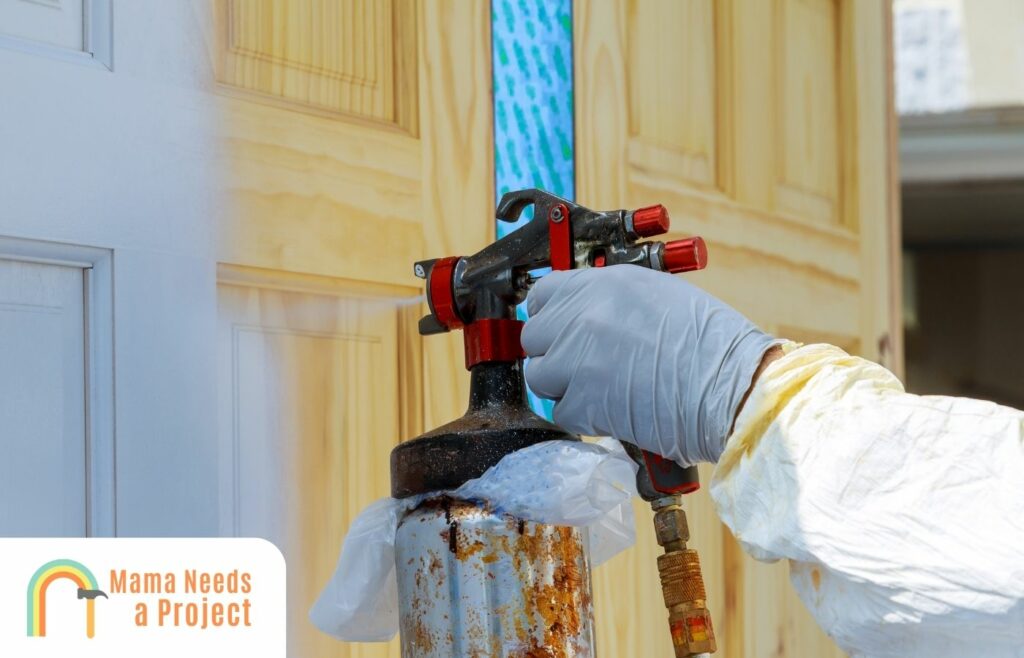
Space
Using spray paint indoors without adequate space is likely to end in a big mess.
If you have a large space that’s mostly empty, you should have no problem setting up a paint screen in the corner.
And with this setup, you won’t have to worry about spray paint overspray, since it’ll go right into the drop cloths and stay clear of any furniture or walls.
Moreover, if you don’t have to worry about space while painting, chances are you’ll have an easier time achieving smooth coats.
Lastly, ensure you have adequate floor space and wall space before you start spraying paint. Take everything off the walls, clear the floors, and set up the necessary number of drop cloths.
Ventilation
Don’t start spraying paint indoors without first ensuring there’s adequate ventilation; this way the room won’t fill up with toxic paint fumes before you’re even done spraying.
Also, it’s best to have a window or two open while using a paint sprayer indoors, and there should also be a ceiling, desk, or floor fan running to ensure proper air circulation.
Even if there’s adequate ventilation, you still need to be wearing protective gear so you’re not adversely affected by the toxic fumes or the pain itself.
Occupants
Make sure the room you’re spray painting in is adequately sealed off from the rest of your home until the project is complete.
This way your family members and/or pets don’t come in and disrupt the painting process.
If young children or pets enter the space while you’re painting, and they’re not aware of what’s going on, they could get blasted by the paint or be over-exposed to the fumes, two situations that can result in health problems.
Time
If you’re going to safely spray indoors, ample time is a necessity.
Especially if you have limited space to work with, you’ll need to be extra careful when spraying, so don’t rush at any point.
And you can’t rush the paint drying process either, because this will result in the paint peeling or chipping off a few days later.
Since most paints take anywhere from an hour to six hours to dry, and since prep takes a half-hour to an hour, don’t paint indoors unless you have 7-10 hours available.
Health Conditions
Having particular health issues makes spraying paint more risky.
And even if you don’t have health concerns to worry about, you must take proper safety precautions before you start spraying.
Specifically, wear chemical protection gloves, a respirator, goggles, long pants, and long sleeves when spray painting.
If these precautions aren’t enough to make you feel safe, do what you can to spray paint outdoors.
Not all spray paints are rife with volatile organic compounds (VOC), but VOC-laden products pose a significant risk to those with respiratory or heart issues.
Spraying Indoors vs Outdoors
Indoors
If you’re spraying paint indoors, you need to be careful not to get paint on walls, doors, windows, floors or furniture.
This can be accomplished by using the right drop cloth setup, which I’ll discuss later when outlining a simple step-by-step process you can follow to safely spray paint indoors.
Again, there will need to be open doors and windows, since you could experience breathing problems caused by the fumes if there’s inadequate air circulation, especially if you’re not wearing a respirator.
But indoors you won’t have to worry about the elements, nor will you have to worry about things that can fall from the sky and negatively affect the paint coatings.
Outdoors
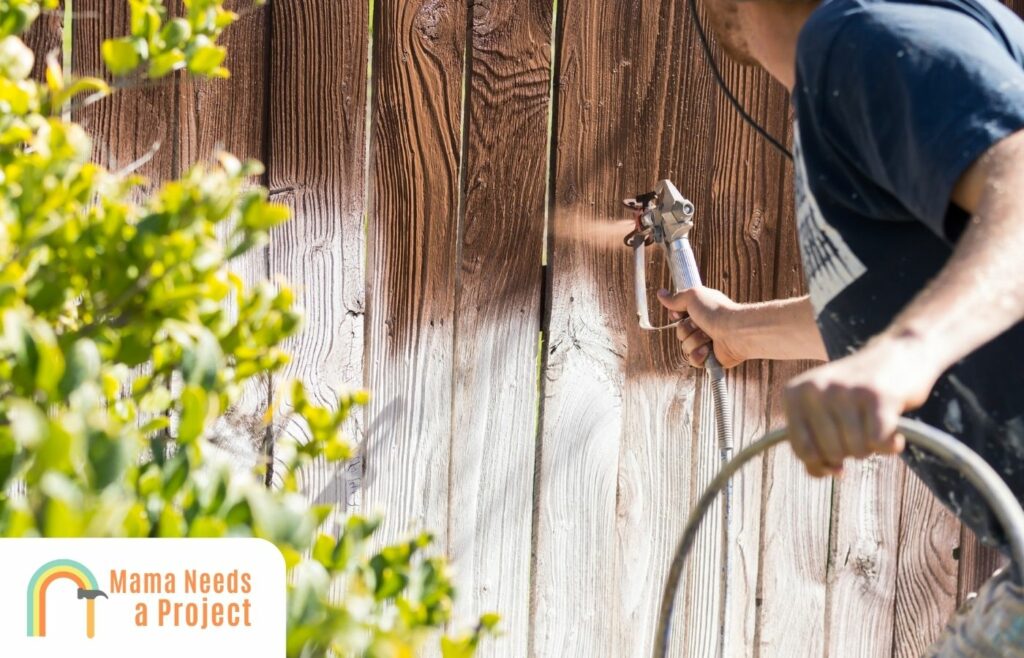
Outdoors it’s a different story; you will have much more space and you won’t have to worry as much about overspraying.
Of course, you shouldn’t overspray a ton, since this is wasteful and amounts to you spraying away the money you spent.
Ventilation won’t be a problem since you’ll be spray painting in the fresh air.
What you do have to be ready for is the paint suddenly, and without warning, blowing back at you because of the wind, and you must also be prepared for an unexpected rain shower.
And don’t forget that leaves and other debris may find their way onto the workpiece, and bugs may crawl or land on it while you’re painting.
Where to Spray Paint Indoors
Workshop
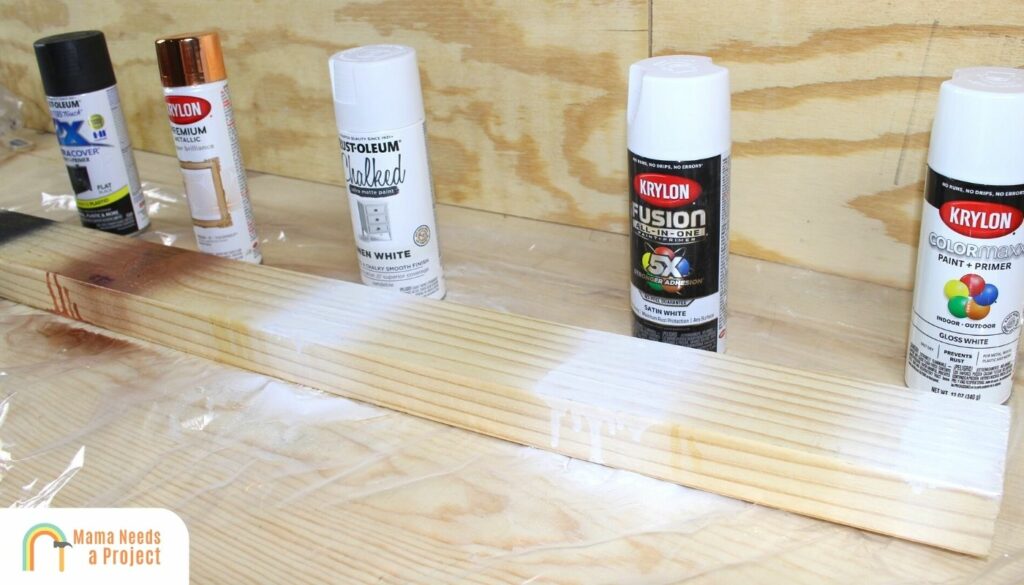
The best place by far for spray painting indoors is a workshop. Here you’ll have all the materials necessary to complete your paint project, and you’ll be away from the main sections of your home to ensure the safety of other occupants.
Of course, not all home workshops are created equal, but the most important element is space. In other words, so long as you have enough space, and decent ventilation, it’s highly likely you’ll be able to complete all your spray paint projects successfully.
Garage
You could spray paint in your garage as well, so long as no vehicles are present and the garage door is open.
Many homes have a garage-workshop, and this kind of space can work if there’s enough space and proper ventilation.
The only thing about the garage is a rogue gust of wind could blow in and redirect the spray paint at you or onto an unprotected surface.
Kitchen
You can spray paint in the kitchen safely, so long as you set up a screen to ensure spray paint doesn’t get on any surfaces that aren’t prepared for it.
And it’s best to only use one of the handful of food-safe spray paints available on the market right now, no matter the surface you’re painting.
Lastly, any kitchen surface that’s been spray painted should be coated with polyurethane or another finish to ensure there’s no risk after the paint dries.
Bathroom
It’s possible to spray paint in your bathroom, but you may run into some problems. For one, if you don’t allow the paint adequate drying time, it could peel off after being exposed to shower steam or water.
Personally, I wouldn’t spray paint in a bathroom solely because of how much water is present; it’s too easy for things to go wrong.
Looking to spray paint wood? Check out these best spray paints for wood projects!
Best Conditions for Spray Painting Indoors
You’ll get the best results spray painting indoors if it’s not too humid. Also, it shouldn’t be too cold nor too hot.
And while there should be decent air circulation, you don’t want to have your fans on full blast, for they’d make painting harder this way.
Also, it’s best if you paint while nobody else is around; this way you won’t get distracted and you’ll have a better shot of getting the project completed on time.
Lastly, you shouldn’t paint while it’s stormy outside, as you could lose power, resulting in the loss of the fans (temporarily) and possibly the sprayer.
Wondering if you can use Rust-Oleum on wood? Check out this guide to learn more!
Sprayer vs Spray Cans
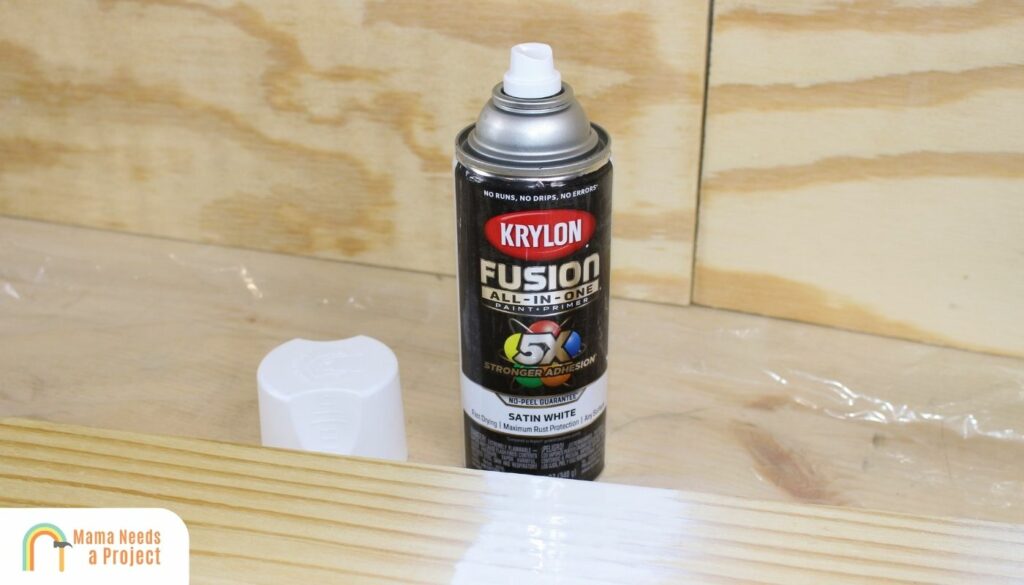
When most people hear the term “spray paint”, they think of the paint that comes in an aerosol can, but this term also refers to spraying paint from a special applicator.
There are pros and cons associated with both applicators.
The aerosol can is easier to use but you’ll need to go through a bunch of cans to get an adequate coat. Plus you don’t have to worry as much about overspraying.
A specially designed paint sprayer, on the other hand, is more complicated (in terms of operation), but it’s great at achieving smooth, attractive surfaces if you know what you’re doing.
And if operated carefully, you will use way less paint, making this applicator more cost-effective.
Check out my Rustoleum vs Krylon comparison to find out which spray paint is best!
Oil-Based or Water-Based Spray Paint Indoors?
You can use either oil-based or water-based spray paint indoors, but there are a few things you should know about both paints before you select one over the other.
Oil-based spray paint is thicker, richer, stronger, and longer-lasting, but it emits more toxic spray paint fumes for a longer period, and if altered in any way during the application or drying processes it can discolor rather significantly.
Water-based spray paint, otherwise known as latex spray paint, is great for both indoor and outdoor projects because it’s quick-drying, easy to apply, visually appealing, and cost-effective. And while it’s not as durable as oil-based spray paint, it’ll still last plenty of years if applied right.
Looking to finish your wood surfaces? Check out these polyurethanes for table tops or these polyurethanes for stairs!
How to Spray Paint Indoors Safely
1. Gather All Your Materials
You’ll need the following materials to spray paint indoors safely:
- Spray paint can (or sprayable paint w/ sprayer)
- Safety gear (respirator, gloves, goggles, long pants & sleeves, ear protection)
- Drop cloths (2-3)
- Easel (2)
- Mineral spirits (or warm soapy water)
- Fine-grit sandpaper
- Vacuum
- Tack cloth
- Primer
2. Prep Your Workspace and the Workpiece
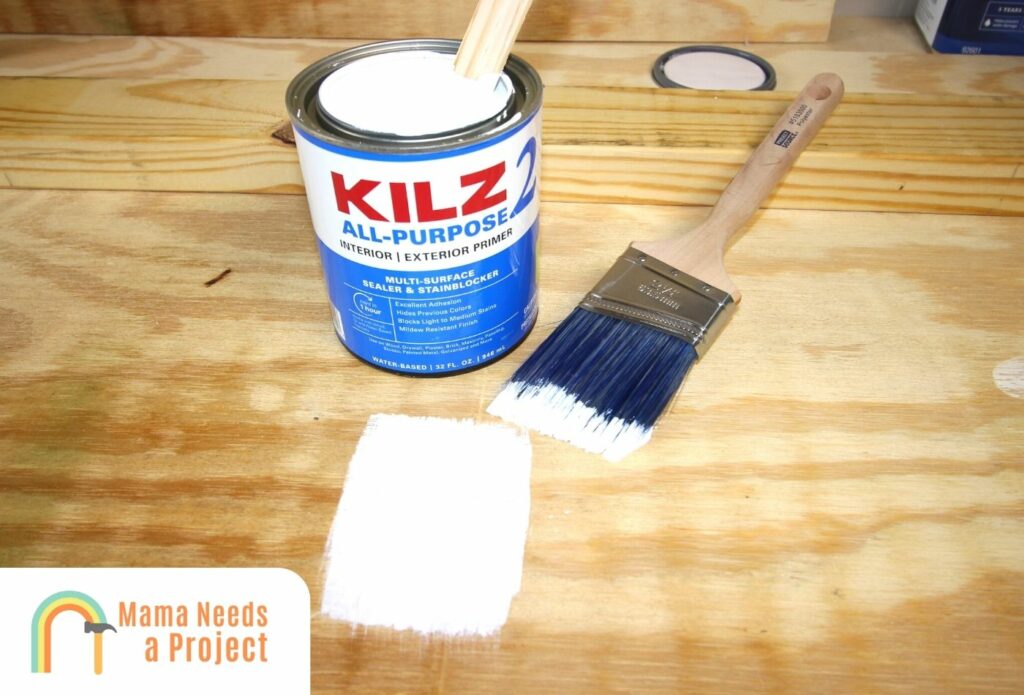
After you have all the necessary materials, you need to prep your workspace and the workpiece.
Find an empty corner in the room you’re working in and lay down a large drop cloth.
Then arrange two easels so there’s one on either wall.
Drape a drop cloth over both easels so a pointed drop cloth screen is formed in the corner.
Now clean off the workpiece with mineral spirits (paint thinner) or warm, soapy water. Then let it dry for 30-60 minutes.
Once dry, rough up the workpiece with fine-grit sandpaper. Then vacuum up the sawdust; a tack cloth will remove any dust the vacuum misses.
Finally, apply a coat of primer so the paint adheres to the surface better. If you’re not sure what primer to use, check out this Zinsser vs Kilz primer comparison to find which is best for your project.
Now the surface is ready for spray paint.
3. Start Spraying
Grab your spray paint cans or load your paint sprayer up with the paint you’ve selected.
When you start spraying, move your arm in a continuous, flowing motion so no section gets more paint than another.
You’ll get the best results when spraying a horizontal surface, but if you need to spray a vertical surface, keep an eye out for drips; these can be eliminated with a tack cloth.
It doesn’t really matter whether you spray up-down or side-to-side; what matters is you don’t spray in a disjointed fashion.
A paint sprayer will have longer range and cover more area, but it will be prone to overspraying.
Cans, on the other hand, have limited range but it’s much easier to avoid overspraying with them.
You can achieve fantastic results with either applicator, so long as you’re careful. And always paint slowly to ensure an even, smooth surface that’s the same shade throughout.
If you’re spray painting larger areas, check out the video below for some more useful tips!
4. Let the Workpiece Dry
Allowing ample time for the paint to dry is critical. If you don’t do this, the paint won’t dry properly, and it’ll probably peel off sooner rather than later—or it’ll look discolored.
You can speed up the drying process by running a fan or two to ensure good air circulation, but you should avoid using heat guns or hair dryers to expedite the drying process, especially if the drying paint is water-based.
Usually, water-based spray paint takes 30-60 minutes to dry, while oil-based takes 5-7 hours.
5. Clean up Your Workspace
Once you’ve applied the necessary number of coats and the workpiece is 100% dry, you can clean up the area.
Wait until all the paint on the drop cloths is dry before you move them; they’ll be easier to clean this way.
Also, clean off your paint sprayer (if you used this applicator) and your safety gear.
Final Thoughts
Spray painting indoors is possible, but you’ll need adequate space, the right safety gear, and an effective paint screen to carry out this task successfully.
Plus, the room should be well-ventilated, the workpiece shouldn’t be too large, and you should be the only one present.
If you feel constrained using either spray paint cans or a standard paint sprayer indoors, opt for spray painting outside instead to be on the safe side.

